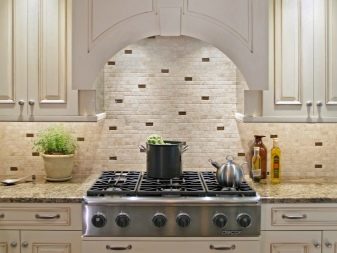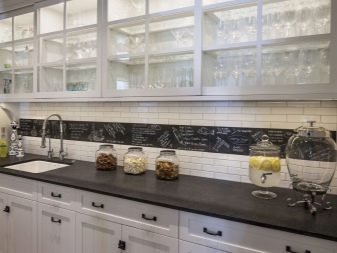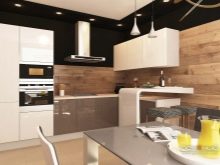Apron design options in the kitchen and their features

The design of the kitchen should not only be spectacular, but also practical, since all working planes near the hob are exposed to temperatures and steam. Thus, in addition to the aesthetic component, it is necessary to rely on the stability of the material from which the apron is made. Ceramic tiles, glass, mosaics - this is not an exhaustive list of possible apron design.



How to choose?
The apron can be safely called the "workwear" of the kitchen. It should be trimmed so that it protects the walls and decorates the interior. Perhaps, the house no longer has such a decorative element, which, in addition to design, has rich functionality. The apron acts as a barrier between furniture, walls and grease, drops, steam, heat. Therefore, it is so important not only to fit it into the overall composition, but also to choose the right material, focusing on the characteristics.
An apron can be the basis of the entire interior, the brightest and most expressive spot around which all interior items unite and harmonize. If you wish, you can reduce its role to a minimum by performing in a neutral color scheme, a calm texture. A great design move is to match the color of the panel and the countertop.
When choosing, you should definitely take into account such a fact as practicality.



Dark materials make all streaks and stains more noticeable, however, they are indispensable if there is a need to dim an overly bright headset. The same can be said about too bright colors - droplets of fat and water are very noticeable on it, so careful care will be required. If the room needs visual stretching, you should pay attention to the design in the form of horizontal stripes. Mirrored surfaces add volume, light ones add air. Against the background of a warm range, food looks more appetizing, this should also be taken into account, especially if you strive to constantly keep your weight normal.
Designers recommend relying not on color, but on an unusual texture.




Neutral palettes to match the walls, furniture or work surface look more advantageous and stylish. Recommendations when choosing are rather arbitrary, you should be guided, first of all, by your taste and characteristics of the apron material.


Materials (edit)
Finishing an apron in the kitchen allows you to use a variety of materials: ceramics and porcelain stoneware, glass, mosaics, steel, wood. The panel may not be installed at all, although it is very impractical to make a surface from wallpaper. Inexpensive type of acrylic and plastic ABS panels are very popular.
When choosing a material, the following nuances must be taken into account.
- Aesthetic component. If the material is very durable, but does not fit into the chosen style, you will have to choose from other options.
- Ease of care. No matter how beautiful the material is, if you constantly need to stand over it with a rag, it is unlikely that it will give you great pleasure. Ideally, grease should be easy to remove without requiring any special cleaning agents. A hard material with a smooth surface is the best choice from this point of view.


- Resistant to moisture. An important point, because water will regularly get on the apron, in addition, it needs to be cleaned regularly. Do not forget that all porous, spongy surfaces, the presence of cracks can become a breeding ground for mold, fungus, microbes.
- Heat tolerance. The cooking zone must be heat resistant.
- Persistence. The stronger the material, the longer the apron will last, despite exposure to heat, water, chemicals for washing, abrasive substances.
- Easy to install. This factor is important if you decide to install the apron yourself.



Let's consider each of the materials separately, evaluating all the pros and cons.
Metallic
A metal apron is an exotic type of kitchen design, however, designers increasingly include it in their projects. Indeed, with the right choice, he will make the kitchen incredibly stylish, unusual, elegant. Such a solution can be considered especially successful in the design of a loft or high-tech, modern, classic, provence, country. This option goes well with materials made of wood, plastic, brick and plaster finishes, glass.
Most often they are made of stainless steel, since this metal is the most budgetary.


However, in addition to stainless steel, brass, copper aprons are made. They are very effective, but quite expensive.
The metal apron can be either matte or glossy, combined. The second option is great for small spaces as it expands the space through reflections. Metal aprons with patterns, designs made in mosaic technique look very impressive. Of the minuses, it should be noted that such a panel will require constant care, every drop will be visible on it, every touch will leave a mark. To prevent this from happening, choose a surface with patterns. Needless to say, the metal is extremely resistant to moisture, temperature, mechanical stress, and does not require special care products.



Of stone
A stone apron can be made of artificial, decorative material or natural. Natural stone is rarely used in kitchen design, as it is very expensive and not particularly durable. The only exception is granite tiles. Compared to beautiful but fragile marble, this is the best option. But analogs of artificial origin are often used in design. They are made of acrylic and quartz, gypsum. The first two perfectly resist moisture, are not subject to deformation. If you decide to install a plaster apron, it will have to be varnished.
Of the minuses, it should be noted:
- high cost;
- impossibility of self-installation without special skills;
- poor combinability with other materials.




Made of wood
A wooden apron is considered a rather controversial decision. The structure of natural wood is too susceptible to moisture, odors, dirt. An obvious plus is the environmental friendliness, naturalness and aesthetic effect of the tree. The surface of such an apron must be properly treated with protective varnishes and oils. A practical solution would be to place a wooden apron behind a glass barrier, however, it is not easy to mount here. It makes sense only if the design solution requires such an element.
It is more practical to replace wood with MDF, HDF and chipboard.


In terms of appearance, almost any interior will only benefit from the presence of a wooden backsplash, especially since it can be easily combined with both a variety of palettes and materials. It also contributes to creating an atmosphere of coziness and comfort.



HDF
This wood-based material is a dense 3 mm board with a UV print pattern and a varnish coating. It is denser than MDF and better withstands moisture. Of the advantages, it is possible to note resistance to impacts, environmental friendliness, long service life, the ability to place spectacular images in the interior, ease of installation, low cost, easy maintenance.
However, there are also disadvantages: size is limited by printing standards, the material may turn yellow, there is a risk of mold and bacteria, and it is easy to deform.Do not use detergents with aggressive composition and abrasive particles.



Chipboard
This is a particle board based on natural sawdust. Modern printing capabilities allow you to make absolutely any composition. You can order your favorite reproduction, family photo, landscape, animals, flowers and so on. From this material, you can create exclusive options that give the interior individuality.
Such an apron will look very impressive, attract attention, eliminate the need for a complex, well-thought-out design.

This is the best way to make something unique for little money. The laminated coating protects the board and the seal from external influences. Installation is very simple, you can handle it yourself. Its disadvantages are the same as those of HDF material, natural wood: short service life, cannot be installed above the hob, otherwise deformation is possible, microorganisms can multiply.


Polycarbonate
This is a sheet of one-piece plastic, similar in structure to glass. It can be colored, transparent. It is very easy to choose a material for any interior, as there are a lot of color and print variations. Polycarbonate gives the impression of fragility, as it looks like a glass surface, but it is a deceptive illusion. It is almost impossible to break it, even if you try.
This apron is easy to clean, just wipe the smooth surface with a detergent, even with an aggressive composition. You do not have to worry that traces of dyes and products will remain on the panel. Polycarbonate has excellent moisture resistance and is not a breeding ground for fungi and microorganisms. The only thing to consider is that saline solutions can leave marks, which, however, can be easily washed off.
The advantages also include ease of installation, sound insulation properties.



Another plus and at the same time a minus is heat resistance to low temperatures, but weak resistance to high temperatures. That is, polycarbonate can be melted and deformed. We'll have to cover the hob with lids.
Design options
Kitchen decoration always requires imagination, funds and knowledge. The countertop, the apron, and the headset itself are very important in the interior of the kitchen. The design should be consistent in the same style, the illumination, the size of the room should be taken into account. The right decor is very important. Sometimes houseplants, textiles, or an aquarium can completely transform a humble design.




When choosing an apron, it is important to consider not only the characteristics of the material, but also the texture and color. By following the recommendations of interior designers, you can save yourself from serious miscalculations.
- You should choose an apron after you have decided on the color of the headset and the general style of the room, you also need to choose the color of the floor, ceiling and walls. Otherwise, there is a risk that part of the interior will "fall out" from the overall picture.
- An apron is able to act as an independent piece of interior, it may be unrelated in color to anything, but this is permissible only in a monochrome design. For example, a kitchen space in white will be very enlivened by a bright colored panel of blue, red, yellow, orange.
- It is effective when the apron partially matches the color of the set, for example, in the area of the hob. The rest of the panel should be neutral.





- Contrasts and opposites are always expressive. Combinations of white and black, red and black are wonderful. In addition, contrast can be used in terms of the choice of textures - matte and gloss get along well together.
- Do not forget that all interior items should be combined with each other, so the overall picture looks more advantageous. It is enough for the green apron to match the color of the upholstery of the chairs to make the interior more organic.
- An excellent move is a combination of an apron with a floor in color, especially if the headset is made in a calm range. Another trick is to choose textiles in the same tone for the duet of the flooring and apron.




- If you don't know what to choose an apron for, then let it be in harmony with the walls. This is the easiest and safest option, especially in a kitchen studio. Or arrange the panel in a color combination with the headset, this will give the impression of the integrity of the composition.
- In the event that your design is limited to two colors, the apron should be decorated in a tone that is the gap between the walls and the floor. In other words, the walls must be lighter than the apron, the floor must be darker.
- An elegant solution is to combine a countertop, an apron and a floor or the first two elements in the same range.



Lighting plays a huge role in the interior.



The backlit headset will enhance the effect of the luxurious bezel. Do not limit yourself to a chandelier, pick up spotlights, lamps in the form of spotlights.
Beautiful examples
The simple laconic interior of the kitchen in a restrained color scheme is perfectly diluted by an unusual metal panel.

A stone apron will perfectly complement the interior in both modern and classic style.

Wood will always be a popular design solution, as natural and natural motives do not lose their relevance.

HDF material allows you to embody absolutely any fantasies in the kitchen interior.

The sophisticated illumination of a polycarbonate backsplash can completely change the whole experience of the kitchen.

For information on how to independently cope with laying an apron in the kitchen, see the next video.













The comment was sent successfully.